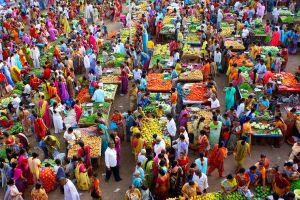Feeding cities presents a major opportunity to improve the plight of millions of small-scale farmers and rural residents trapped in subsistence agriculture and joblessness.
Transforming Food Systems in an Urbanizing World
Introduction
Growth in the world’s cities is exploding. Today, more people live in urban areas than in rural areas. By 2050, 66 percent of the world’s people are expected to live in cities, fueling unprecedented demand for food. Especially in low- and middle-income countries (LMICs) in Asia, Africa, and Latin America, feeding urban populations has become an urgent and critical challenge.
As cities grow, diets are changing. Urban consumers are demanding a more diversified diet, including fruits, vegetables, dairy, and meat, and are increasingly consuming processed foods. Accompanying these shifts is the transformation of supply chains, affecting farmers, small- and medium-sized enterprises (SMEs), and consumers. A process has begun, which will continue for decades, that is transforming food systems from farm to fork.
These trends are occurring alongside other pressures on food systems. Explosive population growth, both rural and urban, will require 50 to 60 percent increases in global food production by 2050 in order to meet demand. Climate change is increasing weather volatility such as droughts, floods, and natural disasters. Obesity rates are skyrocketing, even as nearly 800 million people worldwide are still chronically hungry and two billion suffer from micronutrient deficiency, creating a triple burden of malnutrition. Refugees are migrating across the globe in the highest numbers since World War II. In the face of these challenges, it is clear that coordinated support and commitment to the development of nutritious, safe, affordable, and sustainable food systems in rapidly urbanizing LMICs is essential to global food security.
Feeding cities presents a major opportunity to improve the plight of millions of small-scale farmers and rural residents trapped in subsistence agriculture and joblessness. Participation in growing urban food markets can provide the rising incomes and rural employment urgently needed to meet rural food security challenges, alleviate rural poverty, and address the devastating lack of jobs among the demographic “youth bulge” in low-income countries.
Up to 90 percent of food consumption in low-income countries comes from domestic sources in rural areas. To supply increased volumes of food demanded by urban consumers, supply chains must lengthen geographically, increasing the potential to reach farmers in more and more distant areas. This not only benefits farmers, but also the rural enterprises along the supply chain like wholesalers, transporters, processors, and input suppliers.
Cities also contain the lion’s share of demand for high-value products such as fruits, vegetables, and dairy, where small-scale farmers can have an advantage because the products are labor intensive. Since the urban market is year-round, farmers are incentivized to grow crops in multiple seasons and to grow higher-value products. Developing the food systems that link farmers to cities will have an enormous impact on rural poverty alleviation and agricultural development.
Meeting urban demand in low-income countries is also a major market opportunity for the private sector, from large domestic local firms and multinational corporations to SMEs. In Africa alone, the agriculture and food sector is expected to reach $1 trillion by 2030. Moreover, the scale of investment needed for food systems to meet urban demand makes it evident that action, innovation, and investment by the private sector will be essential to feeding cities.
Despite the opportunities, the transformation of food systems and the development of supply chains will not inherently include small-scale farmers. There is a risk that many will be left behind. Especially vulnerable are farmers in areas far removed from cities and farmers who lack the resources needed to increase production and meet the standards often required by urban markets. Women farmers, for example, are often already more marginalized than their male counterparts and may find it difficult to access these new markets. If small farmers are excluded from urban markets and food system transformation now, they risk being stuck in perpetual, semisubsistence farming for generations to come and becoming part of the “lagging regions” of tomorrow, persisting in poverty decades after their compatriots have climbed the economic ladder to greater health and well-being.
It is critical that the development of food systems to meet urban demand includes small farmers and also the rural entrepreneurs in the small enterprises along the supply chain. Inclusive growth will require smart and deliberate investments by governments and the private sector. Inclusive investments are a win-win for everyone. Analysis has found that the $7 trillion global food and beverage industry will not be able to continue delivering the financial returns expected by companies’ shareholders without tapping into small-scale farmers’ productivity. Government policies in LMICs from the national to the municipal level must also support small farmers and rural economies and create an enabling environment for investment.
But US leadership will be essential. Since World War II the United States has led global efforts to mitigate hunger and malnutrition, and US policymakers must lead global food security efforts today. This leadership must come from both the current and the next presidential administration as well as bipartisan leadership in Congress.
US interests are at stake. Growing markets offer enormous new investment opportunities for US business, and strong global food systems will contribute to the long-term affordability and safety of food for consumers around the globe, including US consumers. On the flip side, food insecurity as a result of high and volatile food prices and lack of secure livelihoods can aggravate already unstable environments, particularly in urban areas around the world. The potential for political, economic, and civil unrest that results is a threat to global security and to US national security.
This report puts forward recommendations for how the US government—in partnership with governments, the private sector, the scientific community, and civil society—can lead the way in ensuring that food systems can feed the world’s cities sustainably while lifting all boats.
Recommendations
Develop, implement, and strengthen policies for global food security
The urgency of the global food and nutrition security challenges cannot be overstated. Exploding populations are increasing demand in cities at unprecedented rates. Investments in agriculture and food systems often take years if not decades to come to fruition and need to be sustained and predictable over the long term in order to yield lasting results. In the absence of a food crisis, agricultural investment often dips, only to leave the world vulnerable to crisis. Without a long-term commitment, the gains that have already been made will be in jeopardy and the challenges of meeting global food demand more difficult if not impossible to achieve. Long-term leadership by the United States will ensure the global community also stays the course in its commitment to this issue. This recommendation calls for:
- Congress to pass authorizing legislation that commits the United States to a long-term global food and nutrition security strategy.
- Agencies to increase support for strengthening low-income countries’ policymaking. Priority areas should include infrastructure development, land tenure, gender and nutrition sensitive agricultural policy, and food safety.
- The administration to lead G7 and G20 global food security discussions and reinvigorate global commitments to food security and agricultural development using the Sustainable Development Goals as a common framework.
- Agencies to support the development of early warning systems in low-income countries to monitor threats to food systems such as food contamination, crop pest and disease outbreaks, livestock disease, and zoonotic threats.
- Congress to pass legislation authorizing the Millennium Challenge Corporation to make regional compacts in order to build regional food systems.
Enable and leverage private-sector investment that includes small-scale farmers and rural SMEs in the food system
Meeting the scale of the challenges posed by urbanization will require investment and innovation by the private sector, from large multinational corporations to small, local enterprises and entrepreneurs. This recommendation calls for the US government, alongside US businesses, to:
- Enable and leverage private-sector investment by US firms and lead multinational efforts to spur private-sector investment.
- Partner with and support local SMEs in low-income countries to foster employment opportunities and build rural economies.
Improve regional trade capacity to build efficient and sustainable food systems across national borders through trade policy
Too often, food systems in low-income countries are hindered by regional trade capacity. The United States should build countries’ regional trade capacity through its trade policies by taking the following actions:
- Promote transparent legal and customs infrastructure, harmonization, standardization, and implementation of procedures and efforts to reduce corruption to help accelerate regional economic integration.
- Encourage use of regional food balance sheets to inform national policies and avoid unnecessary protectionism.
- Establish and designate the position of US Department of Agriculture (USDA) undersecretary of trade and foreign agricultural affairs.
Strengthen research support and expand the research agenda to build food systems
In light of the growing pressures from urban demand, the entire agriculture research enterprise in the United States and around the world needs to focus on solving the challenges facing food systems. This recommendation calls on the United States to:
- Increase research investment for building productive, sustainable, and efficient food systems. Areas of focus include increased productivity, resilience, and transportability of foods; improved harvesting and storage technologies; water utilization and conservation; climate resilience from farm to fork; and leapfrog technologies.
- Launch a new Feed the Future Innovation Lab focused on food systems’ efficiency.
- Invest in the next generation of scientists, entrepreneurs, and leaders in low-income countries.




